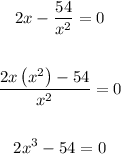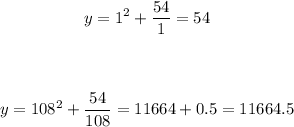Given the equation:

Let's find the global maxima and minima values for the function on the interval [1, 108]
To find the global maxima on the interval, let's first find the derivative:

Set the derivative to zero and solve for x:

Add 54 to both sides:
![\begin{gathered} 2x^3-54+54=0+54 \\ \\ 2x^3=54 \\ \\ x^3=(54)/(2) \\ \\ x^3=27 \\ \\ Take\text{ the cuberoot of both sides:} \\ \sqrt[3]{x^3}=\sqrt[3]{27} \\ \\ x=3 \end{gathered}](https://img.qammunity.org/2023/formulas/mathematics/college/1v6p45zgeyzbwl9cbsgc6fecrgpmgl636p.png)
Substitute 3 for x in the original function and solve for y:

Therefore, the global minima is: (3, 27)
To find the global maxima, solve for the following:
at x = 1 and at x = 108

Therefore, the global maxima is: (108, 11664.5)
ANSWER:
Global maximum: (108, 11664.5)
Global minimum: (3, 27)